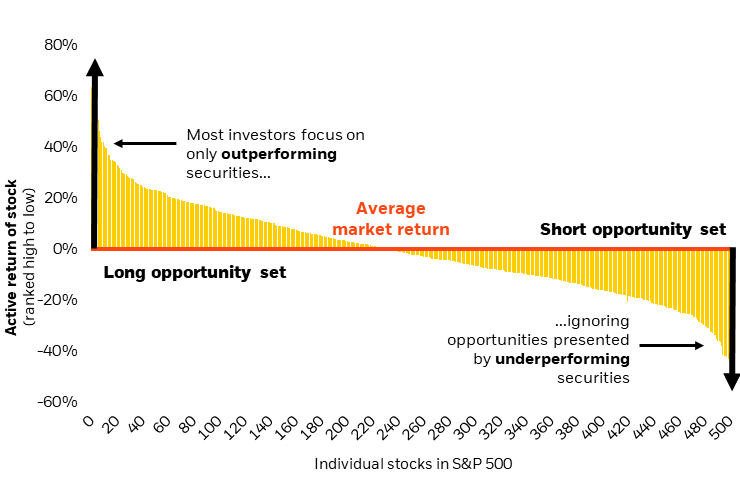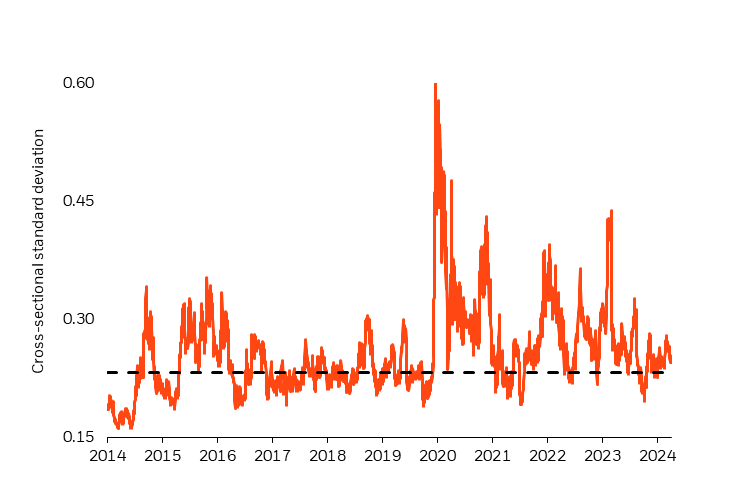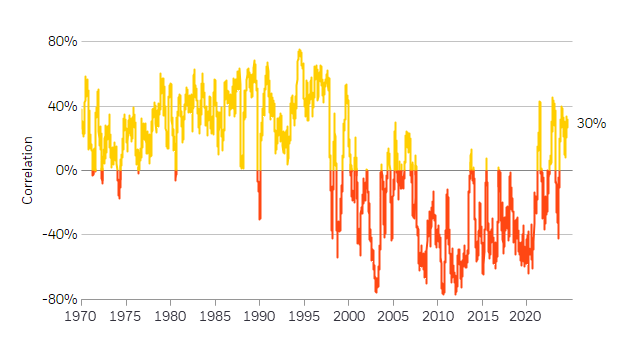Key points
- As macroeconomic and market uncertainty persists, investors may want to consider complementing traditional asset classes with additional sources of diversification and return.
- Market neutral strategies may help to improve portfolio outcomes by expanding the investment opportunity set, taking advantage of heightened security dispersion, and providing a diversifying return stream with a low correlation to broad asset classes.
- Systematic processes may maximize the effectiveness of market neutral investing—enabling a granular and nimble approach to investment analysis and implementation.
Macroeconomic and market uncertainty has remained front and center as the new investment regime continues to play out. The dynamics of stable growth, low rates, and low inflation that persisted in recent decades have shifted, creating a new era for investors.
The previous macroeconomic regime known as the Great Moderation generally supported stable returns and reliably low correlations between stocks and bonds—making the traditional 60/40 allocation1 an ideal asset mix for many investors. Now, investors may need to rethink portfolio construction by complementing traditional asset classes with new sources of diversification and return. While there’s no one-size-fits-all solution, market neutral strategies may help to improve portfolio outcomes by offering a diversifying return stream with a low correlation to broad asset classes.
What is market neutral investing?
As the name suggests, market neutral strategies are designed to target returns that are independent of market direction. Compared to active long-only strategies that invest only in the highest conviction stocks and avoid those with a less favorable outlook, market neutral strategies are able to make both long and short investments.2 As shown in Figure 1, this expands the opportunity set for return generation, allowing investors to express a broader range of active views (positive, less positive, or negative) across each stock in the investment universe.
Figure 1: Market neutral investing expands the investment opportunity set
Example opportunity set for a market neutral strategy

Source: BlackRock Systematic, as of July 2024.
A relatively even split of long and short investments results in a net market exposure of zero. This greatly reduces the influence of market fluctuations on the strategy’s returns. Instead, returns are driven by security selection and the ability to effectively forecast the relative return differential between long and short holdings.
In practice, if the short side of the portfolio lags the long side of the portfolio (in line with forecasts), then those positions will contribute to the strategy’s return potential regardless of market direction. Figure 2 illustrates this concept in the event that markets are trending upwards. If Holding A is projected to increase by 12% and Holding B is projected to increase by 2%, an investor would buy A and short sell B to target an expected return of 10% (before factoring in transaction costs) without exposure to the overall market.
Figure 2: Market neutral returns are driven by security selection across long and short positions, regardless of market direction
Projected returns of a long position (Holding A) and short position (Holding B)

Source: BlackRock Systematic, as of July 2024. For illustrative purposes only.
When are market neutral strategies expected to perform best?
The spread in performance between long and short positions is where the alpha3 opportunity exists for market neutral strategies. This means that the more variation there is in performance across securities, the richer the opportunity set is for return generation.
In recent decades, an abundance of central bank liquidity and low borrowing costs supported stable returns for most assets and suppressed security dispersion—or the degree of difference in performance across single securities. Now, macro volatility is creating a more dispersed market environment as individual companies differ in their ability to adapt to challenges like persistent inflation and higher interest rates.
Dispersion is a return source that’s not captured in the traditional 60/40 construct. While stock and bond returns are highly dependent on economic and market conditions, dispersion can exist regardless of market direction. Importantly, it tends to be the highest when markets are volatile and uncertain—the very time that 60/40 portfolios need the most help. Figure 3 shows how equity return dispersion has risen above its historical average. As the previous ‘rising tide lifts all boats’ environment appears to have come to an end, the opportunity to take advantage of the relative return differences across securities makes a market neutral approach increasingly compelling.
Figure 3: Equity return dispersion has risen above its historical average
Cross-sectional standard deviation of trailing 3-month S&P 500 returns

Source: BlackRock Systematic, with data from Bloomberg, as of June 2024.
How can market neutral strategies improve portfolio outcomes?
Macro volatility has also shifted the diversification properties of 60/40 portfolios that have been foundational to portfolio construction in recent decades. Figure 4 illustrates how the historically negative correlation between stocks and bonds has become less reliable in a world of higher interest rates and inflation.
Figure 4: Stock-bond correlation has been less reliably negative in the new regime
Rolling 90 day correlation of US 10Y Treasury and S&P 500 daily returns

Source: LSEG Datastream, chart by BlackRock Investment Institute, July 2024
The degree of diversification that bonds can provide is likely to remain less reliable as the new regime of heightened market uncertainty persists. By accessing new return sources like security dispersion that are independent of market direction, market neutral strategies tend to exhibit a low correlation to traditional asset classes and even other alternative solutions. This provides the added source of diversification that’s needed in the 60/40 portfolio today.
A systematic approach to market neutral investing
We discussed the potential of market neutral strategies to expand the investment opportunity set, take advantage of new return sources, and provide an added layer of diversification in portfolios. However, not all market neutral strategies are created equal. In our view, a systematic approach helps to maximize the effectiveness of market neutral investing.
Systematic processes enable granular, data-driven analysis to be scaled across the entire breadth of the market every day. Stocks are then scored and ranked daily, combining into a view of the extent that each security is expected to outperform or underperform on a relative basis. The breadth and speed of analysis allows systematic investors to quickly identify alpha opportunities as they arise across the market. Beyond security selection, systematic processes support the rapid recalibration of portfolios that’s necessary to remain nimble in a more volatile regime.
Finally, investment insights are implemented through a process that explicitly balances return considerations with risk and cost tradeoffs. This helps to limit unintended bets or concentration risks that can surface if not closely monitored. The ability to scale investment insights, capture alpha opportunities, and manage risk exposures makes a systematic process well-suited for market neutral investing.
Conclusion
The benefits of market neutral investing have become increasingly relevant amid heightened uncertainty and volatility. As investors look to evolve the traditional 60/40 portfolio to address today’s challenges, market neutral strategies may help target differentiated return sources like security dispersion to complement existing allocations with an additional source of diversification and return. Taking a systematic approach can help to maximize the effectiveness of market neutral investing—providing the breadth, granularity, and speed that’s needed to capture opportunities in the new regime.
To obtain more information on the fund, including the Morningstar time period ratings and standardized average annual total returns as of the most recent calendar quarter and current month-end, please visit:
You should consider the investment objectives, risk, charges and expenses of the fund carefully before investing. The prospectus, and if available, the summary prospectus contain this and other information about the fund and are available, along with information on other BlackRock funds, by calling 800-882-0052 or from your financial professional. The prospectus should be read carefully before investing. Investing involves risk including possible loss of principal.



